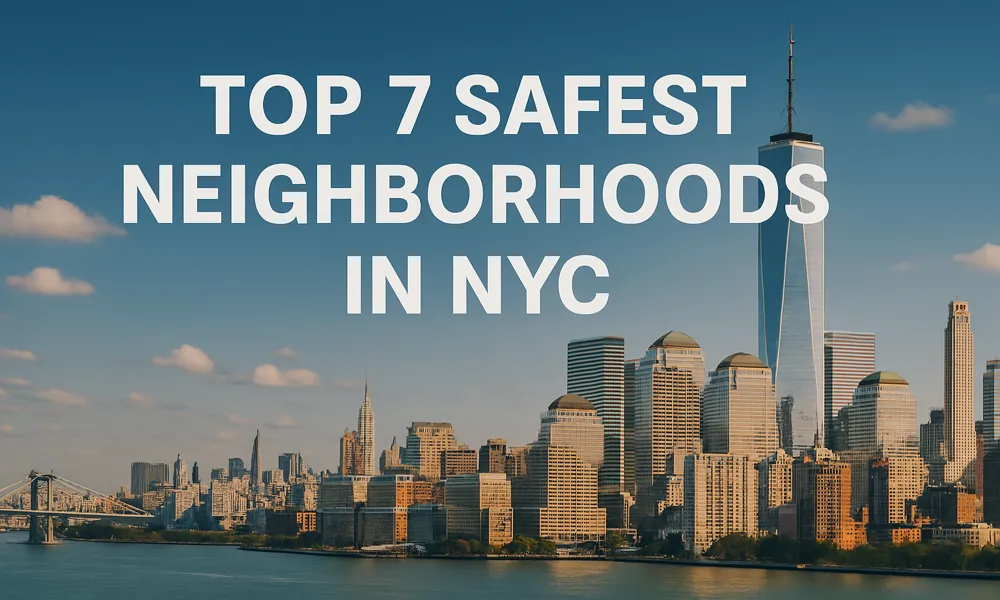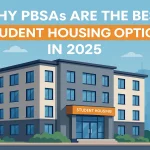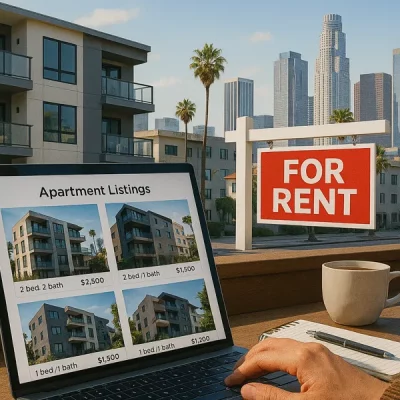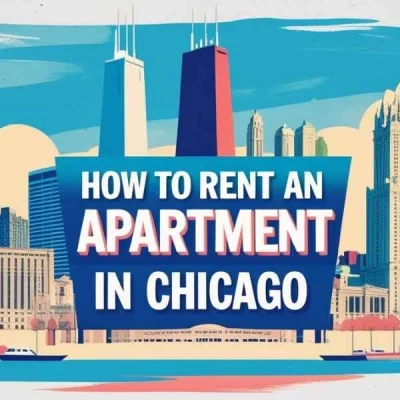Top 7 Safest Neighborhoods for Students in NYC
Table of Contents
Moving to New York City for college? You’re not alone—and you’re in for one exciting chapter! From iconic skylines to buzzing student life, NYC has something for everyone. But let’s be real—choosing where to live in such a big city can feel overwhelming, especially if safety is at the top of your checklist (as it should be!). In this guide, we’ve broken down the seven safest neighborhoods for students in NYC—with everything from crime stats and rent estimates to what makes each area student-friendly. Let’s help you feel at home—and safe—in the city that never sleeps.
What Are the Safety Rankings of NYC Neighborhoods in 2025?
Let’s be real—safety is a top priority when choosing where to live in a massive city like New York. For students moving from different states or even different countries, settling into a safe, secure neighborhood can make all the difference in feeling at home.
In 2025, New York City continues to offer a wide range of neighborhoods that are not only safe but also student-friendly, well-connected, and culturally rich. While crime rates in NYC have generally trended downward over the past five years, the difference between neighborhoods can still be significant. Below are the Safety Rankings of NYC Neighborhoods 2025:
| Neighborhood | Crime Rate (per 1,000 residents) | Safety Index Compared to NYC Average | Why It’s Considered Safe |
| Upper East Side (Manhattan) | 6.2 | 30% higher | Extremely low crime rate, strong police presence, and family-oriented vibe. |
| Battery Park City (Manhattan) | 8.5 | 25% higher | Gated areas, waterfront walks, and very low traffic make it super secure. |
| Columbia St. Waterfront District (BK) | 12.5 | 40% higher | Quiet and secluded with community policing and low residential crime. |
| Brooklyn Heights (Brooklyn) | 17.6 | 15% higher | Calm, historic area near the promenade—great lighting and walkability. |
| Kips Bay (Manhattan) | 21.92 | 10% higher | More residential than surrounding areas, close to colleges and med centers. |
Top 7 Safest Neighborhoods in NYC for Students (with Rent Estimates)
NYC is a big, fast-paced city, and knowing which neighborhoods offer the right mix of security, affordability, and student-friendly vibes can make all the difference. In fact, a recent 2024 student housing survey found that over 70% of students ranked safety as their #1 concern when choosing where to live.
Whether you’re studying at NYU, Columbia, Baruch, or a smaller college, feeling secure in your neighborhood is essential for your peace of mind and academic success. The good news? NYC is home to several neighborhoods that are not only safe, but also welcoming, well-lit, community-oriented, and close to major universities. Let’s dive into the top seven safest neighborhoods for students in New York City—along with average rent prices:
| Neighborhood | Borough | Avg. Rent (1-BR) | What Makes It Safe | Nearby Universities |
| Battery Park City | Manhattan | $5,000 | Gated residential buildings, 24/7 security, minimal street traffic, strong community policing | Pace University, NY Film Academy |
| Brooklyn Heights | Brooklyn | $3,000 | Well-lit streets, strong community engagement, low crime rate, neighborhood watch presence | St. Francis College, St. Joseph’s University |
| Kips Bay | Manhattan | $3,500 | Residential zoning, medical centers nearby, high police visibility, lower violent crime rates | Baruch College, NYU College of Dentistry |
| Upper East Side | Manhattan | $2,385 | Low crime statistics, family-oriented area, secure doorman buildings, access to emergency services | Hunter College, Cornell Medical, Marymount |
| Columbia St. Waterfront District | Brooklyn | $2,800 | Quiet and secluded, small population density, active neighborhood associations | NYU Tandon, Pratt Institute (nearby) |
| Fresh Meadows | Queens | $2,200 | Suburban vibe, very low crime, lots of families, strong school presence, police precincts nearby | St. John’s University, Queens College |
| Bay Ridge | Brooklyn | $1,594 | High safety score, strong community culture, consistent patrols, lower rent attracts students long-term | LIU Brooklyn (via R train), College of Staten Island |
What Makes These Neighborhoods Ideal for Students?
Finding a safe place to live is step one—but for students, there’s more to the story. The best neighborhoods for student life in NYC aren’t just safe—they’re convenient, well-connected, budget-aware, and buzzing with energy that supports both study and social life. According to a 2025 NYC Student Housing Survey:
- 81% of students said proximity to campus is a top priority.
- 73% prefer neighborhoods with access to libraries, gyms, and study-friendly cafés.
- More than half rely on public transit to commute to class, internships, or part-time jobs.
Below are the student friendly features of NYC’s Safest Neighborhoods:
| Neighborhood | Transit Access | Key Amenities |
| Battery Park City | Subway (1, R, W) + PATH + Ferries | Waterfront parks, Whole Foods, gyms, 24/7 security |
| Brooklyn Heights | 2, 3, A, C, R subways | Promenade views, indie bookstores, cozy cafés, yoga studios |
| Kips Bay | 6 subway + crosstown buses | Trader Joe’s, medical libraries, East River running paths |
| Upper East Side | 4, 5, 6 and Q trains | Museums, Central Park, study cafés, secure residential blocks |
| Columbia Waterfront (BK) | B61 bus + access to F/G subway lines | Parks, farmer’s markets, coffee shops with study-friendly seating |
| Fresh Meadows (Queens) | Express buses, LIRR nearby | Public libraries, suburban parks, major groceries like Key Food & H-Mart |
| Bay Ridge | R train + ferry options | Cheap eats, open study spots, walking trails, tight-knit community |
Tips for Finding Safe Student Housing in NYC on a Budget
Let’s be honest—finding a safe and affordable place to live in New York City can feel like searching for a needle in a haystack. Between high rents, fast-moving listings, and endless online options, it’s easy to feel overwhelmed—especially if it’s your first time renting. But here’s the good news: with the right tools, timing, and tips, you can find a student-friendly apartment that fits your budget and keeps you safe. According to NYC’s Student Housing Trends Report 2024:
- The average NYC student spends $1,200–$1,500/month on shared housing.
- Over 60% of students share an apartment with at least one roommate to reduce costs.
- Students who start their housing search 3+ months in advance are 35% more likely to get better deals and safer units.
Following are some of the smart tips to secure safe & budget-friendly student housing in NYC:
- Start Early (Seriously!): The best deals don’t last long in NYC. If you wait until the last minute, you’ll either overpay or compromise on safety. So, start your search 2–3 months before your move-in date, especially for fall intakes. Spring and summer are peak rental seasons—early birds get the best spots!
- Use Your University’s Housing Support: Most NYC universities have housing portals, student bulletin boards, or recommended landlord lists. Check if your university has a housing office or a Facebook group for admitted students—you’ll often find trusted listings there!
- Split Rent with Roommates: Sharing a 2- or 3-bedroom apartment can cut your costs by up to 40%. It’s also safer—you’re rarely home alone. You can split not just rent, but also utilities, internet, groceries, and even furniture.
- Explore Trusted Student Housing Platforms: University Living specialize in verified, student-specific housing near NYC universities.
- Visit the Neighborhood (or Take a Virtual Tour): You can’t tell everything from a photo. Go see the place—or at least explore the neighborhood on Google Street View or during a virtual tour.
Conclusion
And there you have it—your student-friendly guide to the safest neighborhoods in NYC for 2025! Whether you’re looking for peace and quiet in Fresh Meadows, waterfront views in Battery Park City, or historic charm in Brooklyn Heights, New York offers a neighborhood for every student’s lifestyle and budget.
Just remember:
- Start your housing search early
- Explore your options using trusted student platforms
- Don’t be afraid to share a place to save on costs
- And most importantly—go with an area where you’ll feel safe and supported
New York City can feel big, but once you settle into the right neighborhood, it quickly starts to feel like home.
Frequently Asked Questions
What are the safest neighborhoods in New York City for students in 2025?
Some of the safest areas for students in NYC include:
Upper East Side
Battery Park City
Brooklyn Heights
Kips Bay
Columbia Waterfront District
Fresh Meadows (Queens)
Bay Ridge (Brooklyn)
These areas offer low crime rates, strong community presence, and student-friendly environments.
Which is the safest area for students to live in Manhattan?
The Upper East Side ranks as one of the safest Manhattan neighborhoods, with a 30% higher safety index than the NYC average. It’s close to several universities and offers secure doorman buildings, family-friendly vibes, and low crime.
Is Brooklyn a safe option for students in 2025?
Yes! Neighborhoods like Brooklyn Heights, Bay Ridge, and the Columbia Waterfront District are among the safest in Brooklyn, offering affordable rent, great subway access, and welcoming student communities.
What’s the average rent in NYC’s safest student neighborhoods?
Here’s a quick breakdown:
Battery Park City: ~$5,000/month (1-BR)
Brooklyn Heights: ~$3,000/month
Kips Bay: ~$3,500/month
Upper East Side: ~$2,385/month
Fresh Meadows: ~$2,200/month
Bay Ridge: ~$1,594/month
Sharing a place with roommates can significantly lower your monthly costs.
Which NYC neighborhood is best for international students?
Fresh Meadows in Queens is popular with international students. It offers a suburban vibe, affordable housing, low crime, and is close to St. John’s University and Queens College. Plus, it’s quieter and easier to adjust to if you’re new to NYC.
How can students find affordable and safe housing in NYC?
Start your search early (2–3 months before move-in)
Use university housing offices and groups
Check student-friendly platforms like University Living or Amberstudent
Room with others to split costs
Visit or explore neighborhoods virtually to check lighting, access, and safety







